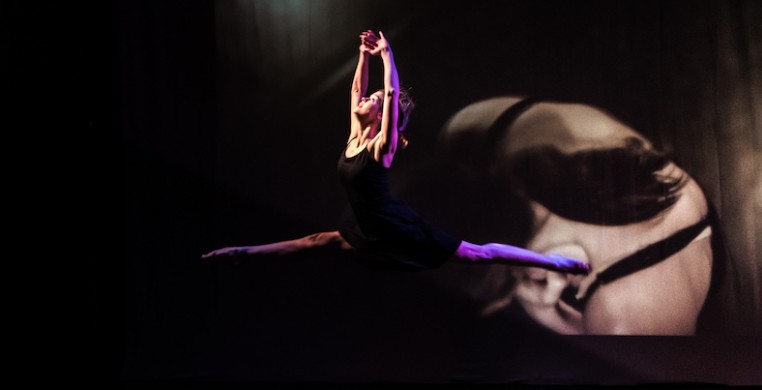Each year, a collective called Still Inspired selects a local visual artist to create four dances by four choreographers. In a cute and cozy third floor venue at the Athenaeum Theatre, artistic director Laura Thurston and choreographers Lizzie Mackenzie, Rebecca McLindon Blanchard and Annie Conway presented dances derived from oil paintings by Elsa Muñoz for Still Inspired's fifth season.
It’s not a novel idea – using art to make a dance – but it’s clear from the model that Thurston has a passion for process, building transparency into her performances. Before each dance started, Muñoz described the intentions behind her work, then the choreographer (in her absence, a dancer from Mackenzie’s piece stood in) shared details about how she turned the painting into a dance. This sort of lec/dem format is, I’m sure, appealing to many audience members, but it also quashes the opportunity for viewers to find their own meaning. In a Q & A after the show, Muñoz said she is rarely tasked with explaining her work, and I wondered what I might have thought of it, and each dance, given the same freedom of interpretation.
Nonetheless, finding moments within each piece which gave reference to their paintings sparked curiosity when abstraction inevitably appeared. Mackenzie’s “A Moment of Grace, Failure to Bond” went furthest from its reference, Muñoz’s “Ponytail.” The painting shows a tender interaction between two young girls – one doing the other’s hair. The dance, on the contrary, takes an ominous tone that seems guided by some of the murkier hues on the canvas rather than its content. Recordings of Robert Munsch’s poem “I’ll Love You Forever,” read by the young voice of Veyda Mackenzie, could be charming on their own; when laid over an electronic score by Marsen Jules it’s downright creepy, particularly against a backdrop of fantastic undulating floor work and isolations from a cast of five.
Thurston’s “Restless” is based on Muñoz’s “At the Table,” an image of a girl seated at an empty dining table gazing out the window. In her description, Thurston talked about her relationship with solitude, particularly as a busy mom who, given a chance to sit still, struggles to let go and rest. Her quartet clearly reflects this, the dancers pausing periodically around a table, or in composed shapes, but never stopping long enough to feel settled in an idea. This seems to be her intension, letting viewers sense that itchy urge to “go” just as soon as we’ve stopped to relax.
Muñoz’s compelling portrait called “The Din” was the impetus for McLindon Blanchard’s “Every Head is a World.” Seated on a bench facing upstage, soloist Sabriah Floberg embodies the internal strife embedded in “The Din,” which shows a woman with a loose, blond bun from behind, her shoulders and neck glowing as she gazes into a dark patch of canvas. Though beautiful, there’s a sense that something is amiss; Muñoz confirms this in her description of the piece, which was inspired by a friend who died tragically at a young age. In the opening, Floberg rubs her palms against her thighs and across her cheeks, shuddering so we see the musculature of her back pulsing. In the distance, Erin Corcoran surveils Floberg, following her every move with a digital camera. On the back wall, a video showing the front side of Floberg gives the impression of a live stream, but it’s a rouse; the few moments when Floberg is out of sync with her image are the ones that really make this work sing, offering a visual feast to which any woman who’s ever felt disconnected from herself can relate.
Closing the evening, Annie Conway’s “Burn Theory” is the only piece which uses a non-human subject as its inspiration. Conway was drawn to Muñoz’s “Controlled Burn” series, a collection of paintings depicting prescribed burns as a means for controlling wildfires and rejuvenating vegetation. With a cast of eight – which is honestly as many dancers as this stage can manage – Conway begins “Burn Theory” with her dancers in the center aisle and just in front of the first row of chairs. They crinkle Saran wrap near our ears, which sounds astonishingly close to smoldering embers while processing the aisle, and make their way to a set of white stools placed on the perimeter of the stage. Conway uses fire as both a means for developing movement vocabulary, with what felt to me like a “hot spot” within low centers of gravity embellished by flourished flickers of arms and legs, and her use of space. The dancers create diagonal chains, which looks to be bands of fire directly taken from Muñoz’s “Controlled Burn Four,” and then break apart to dance around a tower of stacked white stools. Curiously, they’re all smiling at the end. It’s an indication – though perhaps too obviously – that fire is not simply destructive, but also creates a clearing for something new to arise.

